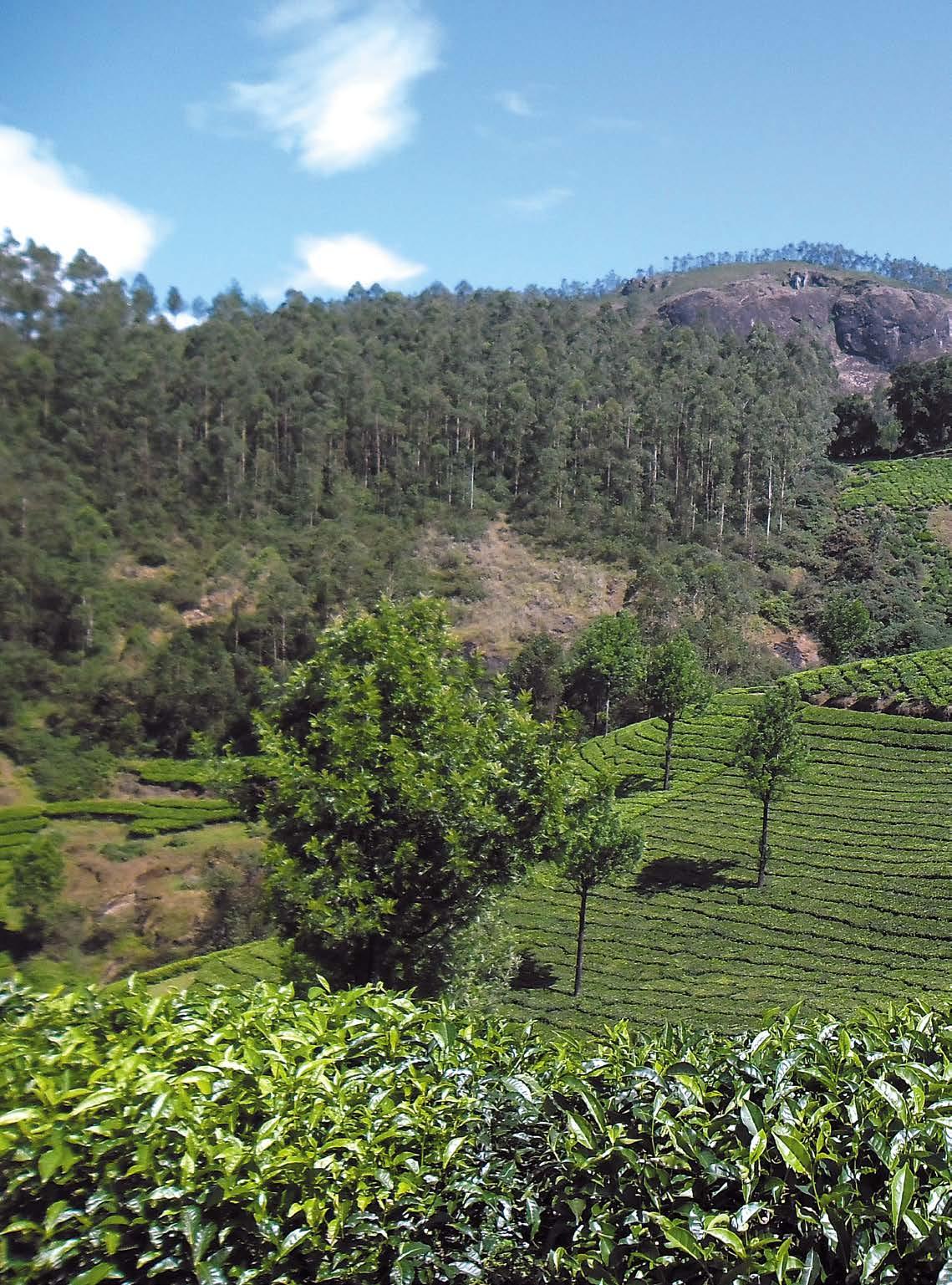
8 minute read
Observations of the South Indian tea industry
Colin Pitt, MNZIFST
Hillside planting at

Hillside planting at Kerala in the Southern Indian Highlands, showing recently trimmed tea plants (Camellia Sinesis) foregraound, terracing, mid view, and Eucalyptus (background) for erosion and soil moisture control.
On a trip to Kerala in Southern India in late 2019 we had the pleasure of a tour of the Lockhart Tea Co-operative plantation and processing facility near the city of Munnar in the highlands above the coastal plains. Munnar is in the Western Ghats mountain range at nearly 1600 metres altitude and has a cooler climate than the rest of Southern India. Monsoonal rains are often followed by extended dry spells so cultivation schedules are critical – as is water management and conservation. Munnar (or Moonar) is named for the confluence of three rivers, and the Mattupetty and Munnar Headworks dams are used for both water storage and power generation. The majority of tea (Camellia sinensis) cultivation is managed by a cooperative that employs, houses and educates its workers and their families. Twelve thousand hectares of tea is grown on terraced hillsides in tightly controlled growth and harvesting cycles that conserve the water, the plants and the land. Processing the tea to the bulk packaging stage adds value and maintains control over the quality presented to exporters. Retail sales on-site and guided tours also bring in revenue. While the land is steep, the soils are rich and were covered in extensive jungle before the British saw the potential for intensive horticulture in the late nineteenth century. Many crops were tried but the similarity of the climate and soils to the well-established tea-growing areas in Assam and Darjeeling saw tea become the major cultivar in the region. Conservation of this soil structure is critical to the health of the industry. Our tour began with a walk through the terraced growing areas. The tea bushes are maintained in an optimum state to maximise the harvest of the most valuable leaves and to diffuse the monsoon rain, to prevent concentrated run-off. The root sward is also managed to ensure absorption of rain and maintain the soil structure. Tea bushes dominate the ground cover and very few weeds grow between the plants. Portions of the land are very steep and we saw several slips where the plants couldn’t quite hold on. These events are regarded very seriously as every area lost is also a loss of production. The accompanying photo of the terraced, contoured nature of the plantings demonstrate the soil and plant conservation strategy as well as the provision of access paths to harvest the leaves. The Australian Eucalyptus trees in the background also served multiple purposes: they have been deliberately planted in areas deemed too steep
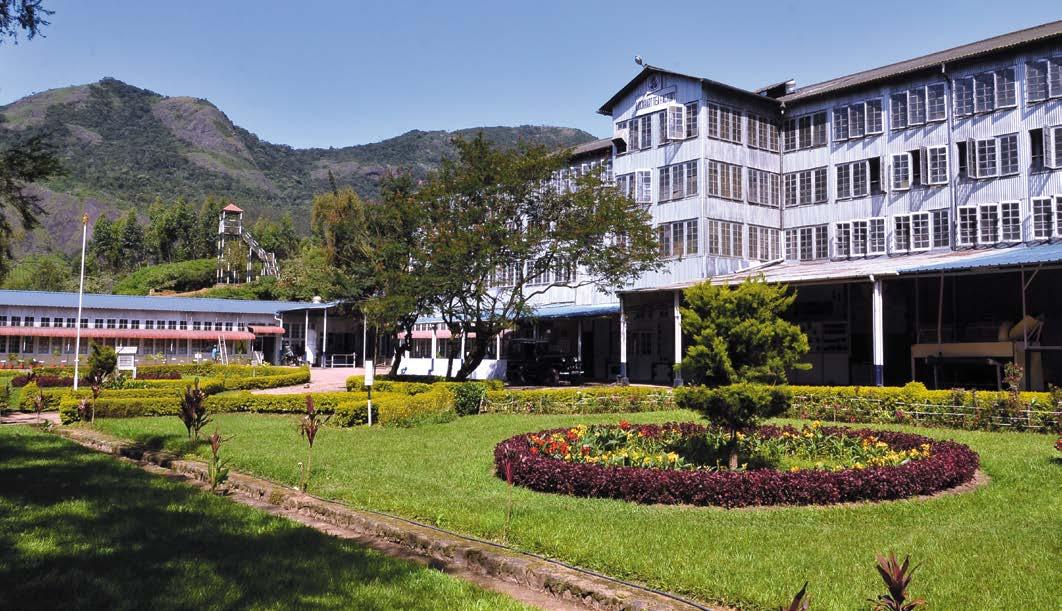
Lockhard tea museum (left) and factory (right) Munnar
and/or too wet for tea to grow. They were chosen for their ability to desiccate and accrete soils that would otherwise run off into the teagrowing areas and make them too wet. They also serve as a fuel source for the processing plant's boilers: trees are coppiced and the wood is stored to dry out, then used to dry the tea. The fertility of the soil and the climate ensure they regain their height within five years, ready for another pruning. Tea plants will grow into a very large shrub or tree if left to grow without management. Tea takes three to five years from planting to production. Plants can live more than one hundred years.
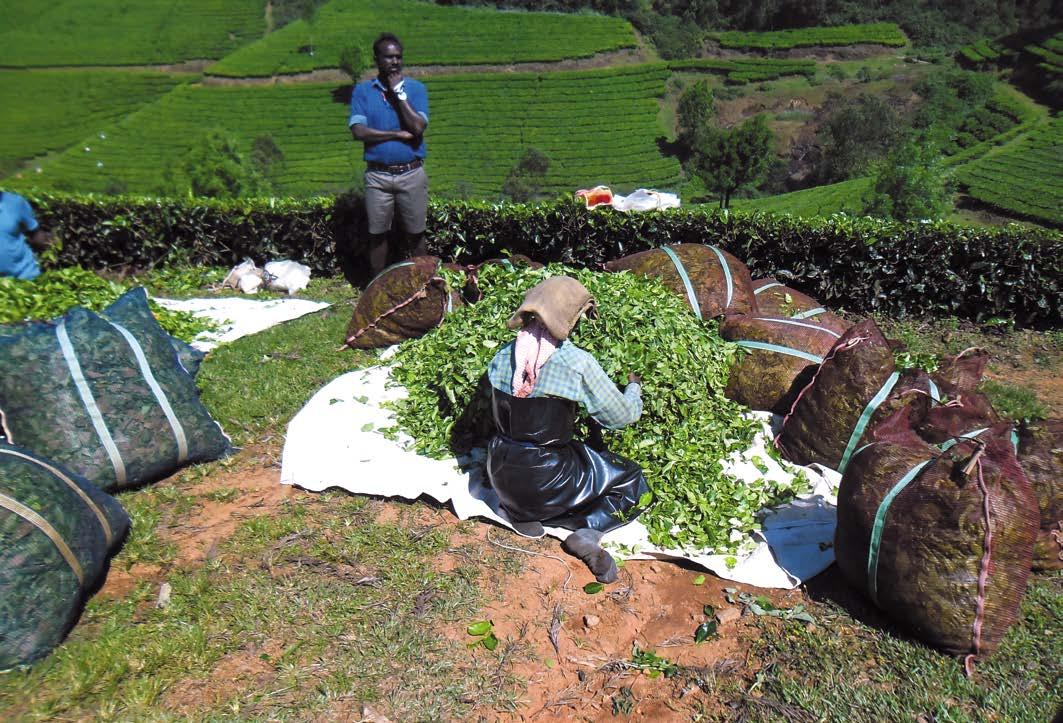
Primary foreign matter sorting on the hillside
Picking
Tea is manually harvested over a two-week cycle. Over the cycle the plant produces three sets of leaves that are classified and destined to become white, green or black tea. The first, uppermost leaves trimmed off are the newly emergent and smallest white tea leaves. The next layer becomes green tea and the final, third layer down becomes black tea. This harvest interval cycle maintains the bushes at the optimum height for the pickers. The leaves are transported in 25kg bags to collection areas in the plantation where they are dumped onto tarpaulins for the first rough sort to separate out any foreign matter, twigs, insects,
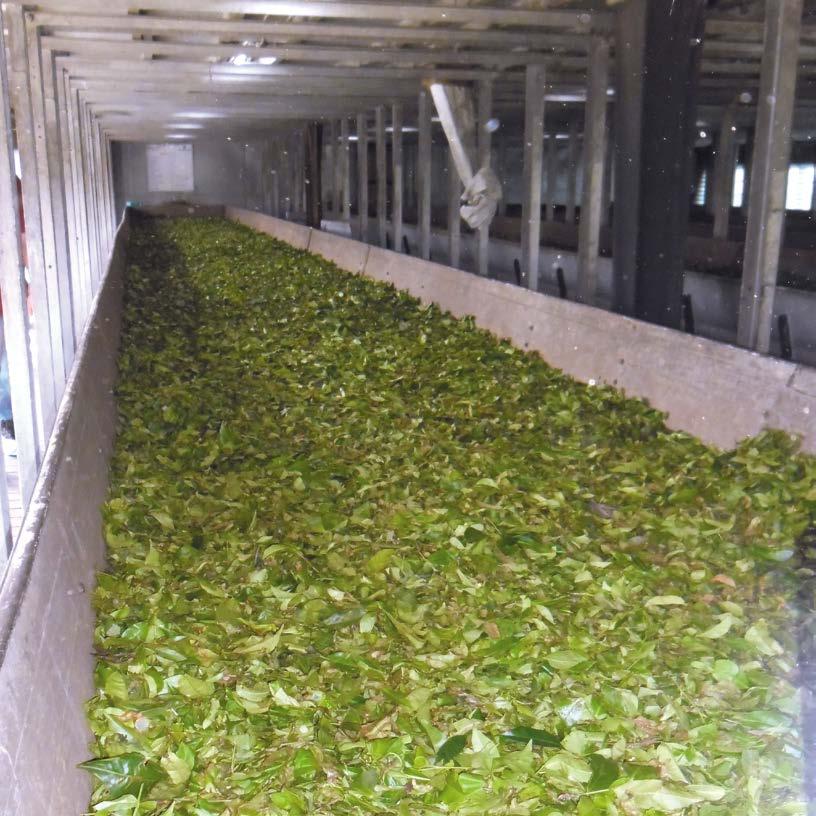
Primary tea drying or withering step on the upper level of the factory
diseased leaves etc. Leaves are then baled up and transported by tractor and trailer to the processing plant. Every aspect of the work described in this paragraph is hard, hot and laborious. The pickers toil in the heat and carry the bags on their heads up very steep paths to the collection points. The sorters work in the sun. All picking is manual with shears working at amazing speed and accuracy.
Withering
Leaves are spread onto large drying racks on the upper floor of the factory. Heated air is pumped from below and temperature and moisture content is monitored. The primary drying step takes approximately twenty-four hours, depending on the initial moisture level.
Bruising or Maceration (CTC – crush, tear and curl)
The leaves are then gravity conveyed down one level to large rollers where they are spread on a round table beneath a heavy rotating horizontal roller head which crushes and rolls them to break open the cell walls and facilitate the next processing step. The machinery in this part of the plant was made in Britain and transported up the mountain one hundred years ago. No mean feat considering the size and weight of each roller. Still going strong after a century, the rolling machines are maintained on-site.

The oxidation step
Oxidation
The next phase is oxidation where the leaves are warmed to encourage release of enzymes to release tannins and other flavour compounds. This process is tightly controlled and the degree of oxidation can produce teas ranging from Oolong (very light oxidation) to Black tea which is completely oxidized. For Black tea, the oxidation process is controlled to produce a specific ratio of theaflavins to thearubigins of around 1:10 to 1:12.The oxidation step is also erroneously referred to as fermentation. The tea darkens markedly over this process. Oxidation is halted at the desired level by raising the temperature and further drying through heated roller drums.
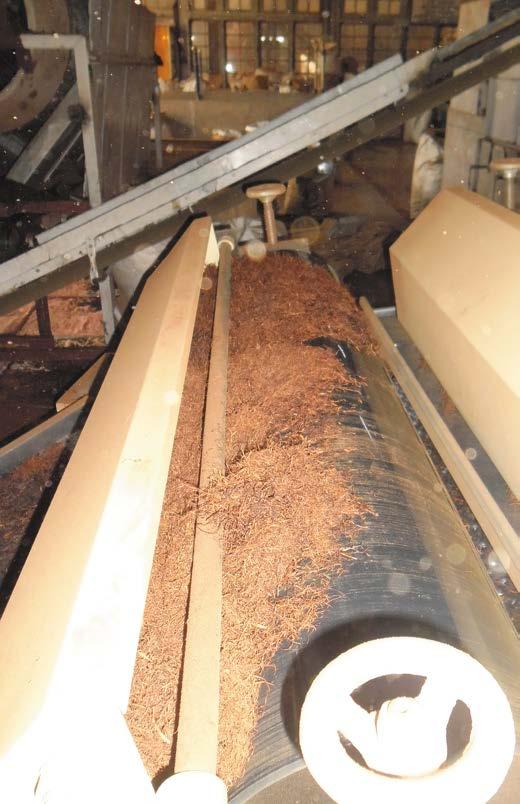
Removal of extraneous foreign matter from dried tea is achieved by passing the product over electrostaticallycharged rollers which separate twigs and any other woody particles from the tea
To stop all enzymatic activity and attain a stable state, moisture is reduced to 3-6%. The product is transported to heated, inclined shaking conveyors that sort by particle size with the finest products collected for processing into teabag grade. Heavier particles which need further drying are transported onto various inclined conveyor/dryer systems until the required moisture content is achieved. The oxidation step is the most sensitive component of the postharvest process. At this stage the leaves are partially macerated and the product is warm, with sufficient moisture content to support microbial growth. The process must be tightly controlled to ensure rapid drying without overcooking and production of over-oxidized flavours. Process monitoring is not automated and relies on the experience of the teamakers to keep within the necessary process constraints.
Museum and tasting
We toured the tea museum and were also treated to a tasting of the entire range of teas produced on site. Tea has a shelf-life of one year from opening; these brews were very fresh and our guide explained the processes behind each subtle variation so well that we came away with a far greater appreciation of the product we take for granted on our supermarket shelves. There is a large vocabulary of tea tasters’ terms to describe some of the variabilities that can occur in the process,
which produce different, off, and sometimes undesirable flavours and colours. Terms such as stewy, smoky, sweaty, bright, coppery indicate variations that can range from differences in growing, harvesting and processing conditions that affect the flavour and quality. Thanks to the hospitable and friendly people of Kerala and the generosity of the workers in the Lockhart Plantation fields and factory, we saw more than the standard tour and our guide had an obvious pride in his colleagues and their products. The plantation and factory jobs are labour-intensive and only the heaviest tasks are mechanised. It was hot, dusty, hard work but the staff were keen to explain their part in the production processes. They were obviously proud of their industry and the quality of the products. The Lockhart Cooperative employs, houses, educates and profit-shares with its workers. The plantation and factory are intrinsic to the local economy and culture. Along with tourism the tea industry underpins the Munnar economy. As we had educators in our party we asked to visit a local school where we were very impressed by the range of resources and the quality of the teaching. The children were a delight and education is obviously highly valued.
Spice Plantation
We also toured a commercial spice plantation growing coffee, cloves, cardamom, nutmeg, ginger and pepper. In contrast to the singlespecies cropping in the tea plantations, the spices were grown in mixed co-cultivation systems, also on steep hillsides. Before we were informed by the guide, these areas appeared to us as wild, verdant, free-growing jungle. Upon entering the plantation, the structured, well-managed and highly-conservative cultivation practices became clear. The hillsides are intensively cultivated but the local wildlife is also accommodated where possible. Drainage systems take water to planting and storage areas. We sampled spices straight from the plant, which were a revelation – fresh cardamom has a much wider flavour profile and an intensity far beyond the products we are accustomed to. Again, the gardening methods are labour-intensive; very few powered tools, lots of people working hard to keep their gardens and businesses maintained. We left with a new-found respect for Indian cultivation practices. What looked like wild jungle on the trip up the mountain was revealed to be highly-structured, well-managed and intensively cultivated gardening systems. Crops are targeted into the appropriate areas on the hillsides and flats and a huge variety of food is grown. Plant nurseries containing extensive beds of seedlings are established in every available growing area. Naturally, we tried the food at every opportunity and can attest to the freshness and intensity of the flavours. The curries were delicious but some come with a warning; the Indian palate seems to be a bit more tolerant of fresh chilli than this Kiwi. I like hot and spicy but I was caught out on a couple of occasions when I ate chillies intended to be placed on the side of the plate. Pass the yoghurt and beer please. A culinary and horticultural experience to be recommended. India is to be savoured and the food and beverage industries are a revelation not to be missed.


